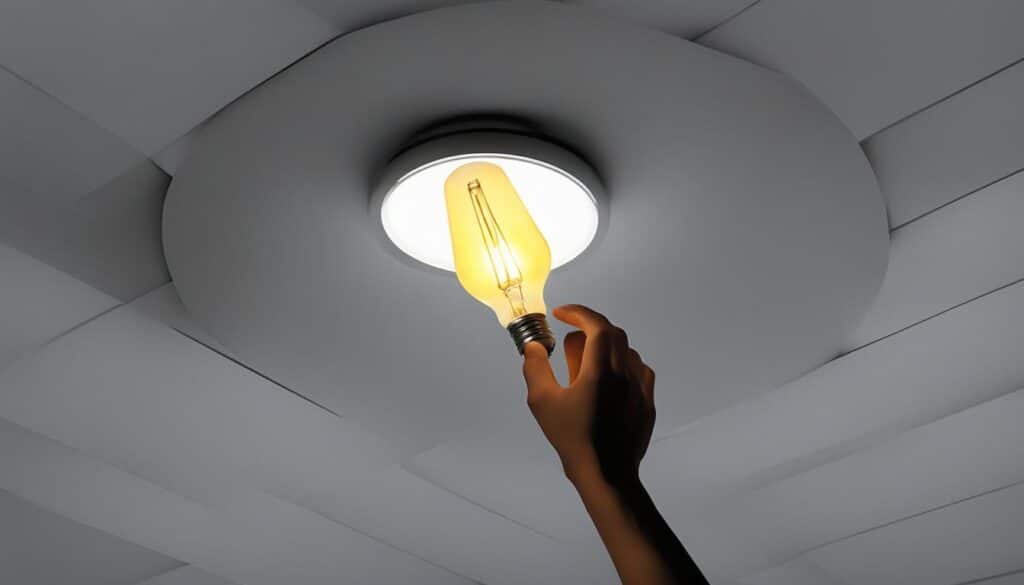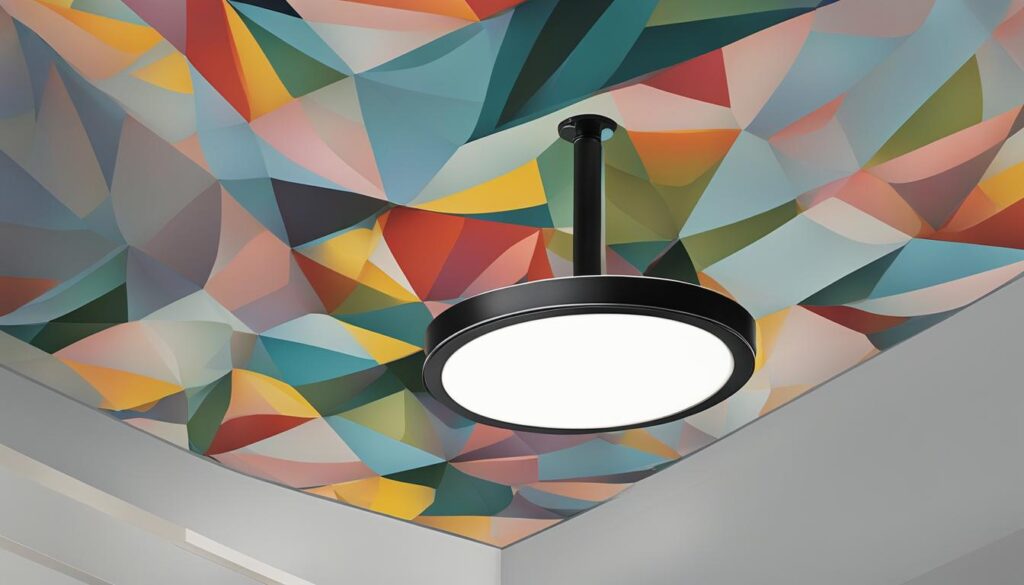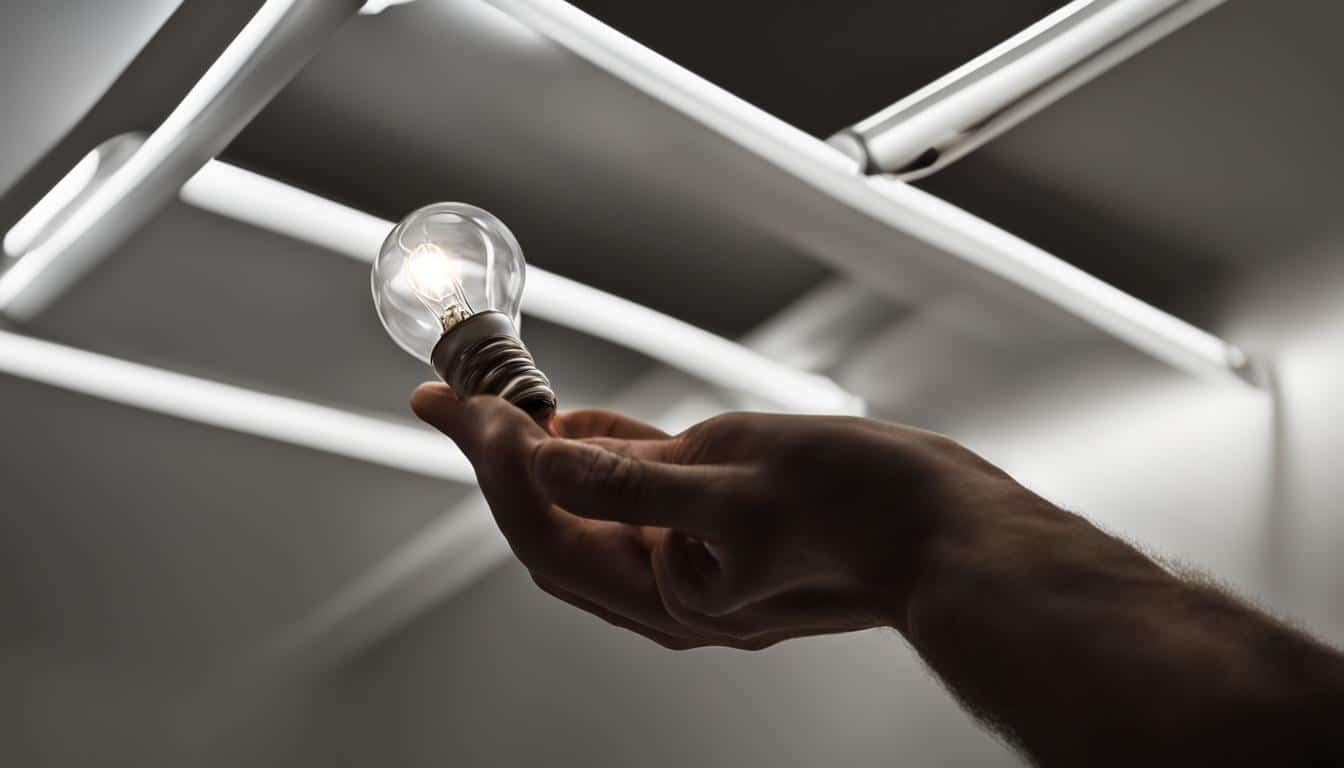Recessed lighting, often referred to as canned lighting, is a popular choice in homes due to its sleek design and versatile functionality. Although the thought of replacing a burnt-out bulb may feel intimidating, I’m here to show you it’s quite manageable! With just a few tools like a sturdy ladder, compatible light bulbs, a screwdriver, and optional safety gear like gloves and glasses, you’ll be able to tackle this DIY bulb replacement for recessed lighting in no time. Just remember to turn off the power at the circuit breaker and let the hot bulbs cool down before starting. Ready to learn how to change bulbs in recessed lighting? Let’s dive in!
Key Takeaways
- Ensure safety by turning off power at the circuit breaker and allowing bulbs to cool
- Choose compatible replacement bulbs to match the fixture
- Prepare with the right tools: a ladder, screwdriver, safety gear, and optional voltage tester
- Various mechanisms secure bulbs in recessed fixtures, such as clips or a twist-lock
- Consider reaching out to a professional for high or hard-to-reach fixtures
Understanding Recessed Lighting: A Primer
Installed directly into ceilings or walls, recessed lighting, also known as canned lighting, provides a seamless and unobtrusive aesthetic adaptable to various décor styles. These lighting fixtures ensure that the light is either flush with the surface or discreetly contained within it. In this section, we’ll delve into what recessed lighting is and its benefits, making it a popular choice for modern homes.
What is Recessed Lighting?
Recessed lighting consists of lighting fixtures that are installed into hollow openings in walls or ceilings, creating a sleek lighting design that blends seamlessly with the surrounding surface. Some variations, such as the Wafer Smart LED Downlight, demonstrate advanced functionality with wireless controls that offer flexibility and ease of use.
Benefits of Choosing Recessed Lighting
Recessed lighting boasts numerous advantages that make it an attractive option for homeowners and designers alike. Notable benefits include:
- Versatility: Its compatibility with a wide range of interior design styles ensures that recessed lighting can suit any environment, whether modern or traditional.
- Space-saving: By integrating directly into walls or ceilings, recessed lighting minimizes obstructions and opens up space, contributing to a cleaner, more modern look.
- Efficiency: Recessed lighting fixtures are typically compatible with energy-efficient LED bulbs, which offer reduced energy consumption and longer life spans compared to traditional bulbs.
- Directional lighting: Many recessed lights come with adjustable features, allowing you to control the direction of the light and highlight specific areas of a room.
These benefits, combined with the sleek and discreet design of recessed lighting, make it a popular choice for many home and business owners looking to enhance their spaces with a functional and stylish lighting solution.
Preparatory Steps for Safe Bulb Replacement
Before diving into the process of replacing bulbs in recessed lighting, it is crucial to ensure your safety. The following tips will help you perform a safe and successful bulb replacement:
- Power off the circuit: Start by identifying and switching off the corresponding circuit to cut power to the fixture. Cutting power is a necessary safety precaution.
- Allow the bulb to cool: If the bulb was recently in use, let it cool down before handling to prevent any burns.
- Wear protective gear: To protect yourself from sharp edges and residual heat or debris, wear gloves and safety glasses.
- Check for voltage: Although optional, using a voltage tester to verify that no voltage is present can be a prudent step before commencing bulb replacement.

By following these safety precautions for bulb replacement, you will be well-prepared to tackle the task of replacing bulbs in recessed lighting. Remember, safety should always be a top priority when working with electrical fixtures.
Choosing the Right Replacement Bulb for Your Recessed Lighting
Finding the perfect replacement light bulb for your recessed lighting can be a daunting task, but keeping in mind bulb compatibility and efficient options can make the process much smoother. In this section, we will explore how to choose the right bulb by understanding compatibility and discussing efficient bulb options for recessed fixtures.
Understanding Bulb Compatibility
When searching for a new light bulb, it’s important to take note of the wattage, size, and type required by the existing fixture to ensure compatibility. For example, a 4″ diameter recessed can typically accommodates the BR30 bulb size, while a 6″ diameter can is more suited for BR40 bulbs. Additionally, matching the wattage specified for the fixture will guarantee safe and efficient operation. Be aware of the socket type as well, as this may vary between fixtures.
Efficient Bulb Options for Recessed Fixtures
When considering efficient bulb options for recessed lighting, LED bulbs have proven to be an excellent choice. They offer numerous advantages over traditional incandescent or halogen bulbs, such as longer lifespan, lower energy consumption, and an instant-on feature that eliminates any warm-up period. LED bulbs also come in various color temperatures, allowing you to customize the ambiance in your space according to your preference.
In conclusion, understanding bulb compatibility and exploring efficient bulb options are essential steps in choosing the right replacement light bulb for your recessed lighting. By considering factors such as size, wattage, and fixture type, you will be better equipped to make an informed decision and have satisfying results with your new light installation.
How to Change Bulbs in Recessed Lighting
Changing bulbs in recessed lighting may seem intimidating at first, but there’s actually an easy method to change bulbs in recessed lighting. This quick guide to changing bulbs in recessed lighting will walk you through the process step by step:
- Turn off the power to the light fixture at the circuit breaker.
- Allow the bulb to cool down if it was recently in use.
- Wear safety gear, such as gloves and safety glasses, to protect yourself from potential injury.
- Remove the old bulb by either pressing the spring clips or turning the twist-lock bulb to disengage it from the socket.
- Insert the new bulb into the fixture, making sure to align it properly and securely.
- Test the installation by restoring power to the fixture and turning on the light.

Different fixture types may require slight variations in the bulb replacement method. For instance, fixtures with spring clips will require you to press the clips to release the bulb, while those with twist-lock bulbs will necessitate turning the bulb to disengage it from the socket.
By following this simple, straightforward guide, changing bulbs in recessed lighting can become a quick and safe task for any homeowner to accomplish. It’s truly that easy!
Tools You’ll Need for Replacing Recessed Light Bulbs
When it comes to DIY bulb replacement for recessed lighting, the right tools can make all the difference. To ensure a smooth and efficient process, it’s essential to have the following tools on hand:
- Replacement Bulb: Be sure to obtain a suitable replacement bulb, matching the wattage, socket type, and size of the original.
- Ladder or Step Stool: A sturdy ladder or step stool is critical for reaching elevated recessed lights. Always set it securely on a flat surface before using it.
- Screwdriver (Optional): A screwdriver may be needed to remove housing or trim that might be obstructing access to the bulb.
- Gloves and Safety Glasses: To protect your hands and eyes while handling the bulbs, wear gloves and safety glasses as a precaution.
- Voltage Tester (Optional): A voltage tester, though not necessary, can offer additional assurance that the power is off before starting the replacement procedure.
Having all of these tools for replacing recessed light bulbs at your disposal will make the process simpler and safer. Remember, the key is to be well-prepared and follow safety precautions while undertaking this DIY task.
The Step-by-Step Guide for Changing Bulbs in Recessed Lighting
Changing bulbs in recessed lighting might seem daunting, but with the right approach, it’s an efficient way to maintain your lighting fixtures. This step-by-step guide will walk you through the process of removing the old bulb safely and installing a new one correctly.

Removing the Old Bulb Safely
First, identify the securing mechanism of the old bulb, which could either be clips or a twist-lock. If it’s clips, disengage them gently by pressing down on them. For twist-locks, rotate the bulb counterclockwise until it disengages from the socket. Be careful when handling the old bulb to avoid breaking it or injuring yourself in the process.
Installing the New Bulb Correctly
Before installing the new bulb, ensure that it’s compatible with your recessed lighting fixture. Then, align the new bulb with the socket and either twist it clockwise into the lock position (for twist-locks) or press it securely into the socket (for clips). Ensure the bulb is snug but not overtightened, as this could cause damage to the socket.
After installing the new bulb, restore power to the fixture by flipping the circuit breaker back on and switch on the light to confirm that the new bulb works correctly. If it doesn’t light up or if you experience any issues, double-check the installation process and the bulb compatibility.
With this step-by-step guide, replacing bulbs in recessed lighting is a straightforward and efficient process. This DIY home improvement skill will ensure that your lighting fixtures remain functional and well-maintained over time.
Expert Tips for Bulb Replacement in Recessed Lighting
Replacing bulbs in recessed lighting fixtures can be more challenging than traditional lighting due to their unique features and placement. To ensure a seamless and safe experience, follow these expert tips for bulb replacement in recessed lighting:
- Always turn off power at the circuit breaker to avoid electric shocks.
- For hard-to-reach recessed lighting fixtures, hire a professional electrician to safely replace the bulbs.
- Utilize creative solutions, such as using duct tape to unscrew flat-surfaced LED lights.
When choosing the right bulb for your recessed lighting, consider these factors:
| Factor | Recommendation |
|---|---|
| Wattage | Match the wattage of the new bulb with the original bulb to prevent overheating and possible damage. |
| Bulb Type | Choose an efficient bulb type like LED or CFL, as they last longer and consume less energy. |
| Color Temperature | Select the appropriate color temperature to match the ambiance and purpose of the room. |
| Compatibility | Ensure the new bulb is compatible with the fixture to avoid socket damage or other malfunctions. |
Bulb replacement can be a straightforward process when following these expert tips and taking the necessary safety precautions. Remember to choose a suitable light bulb that matches your recessed lighting fixture requirements and always prioritize safety when working with electrical fixtures.
Troubleshooting Common Issues When Replacing Recessed Bulbs
While replacing bulbs in recessed lighting might seem easy, it’s not uncommon to come across a few obstacles. This section provides helpful tips on troubleshooting issues during the replacement process, including dealing with stuck or hard-to-reach bulbs and handling broken bulbs within the fixture.

Dealing with Stuck or Hard-to-Reach Bulbs
Whether your bulbs are located in a high-ceilinged space or awkwardly positioned, replacing them may present a challenge. One useful approach is to use a pole with an attachment specifically designed for changing bulbs, which can help access bulbs that are hard to reach. This method can efficiently address issues when troubleshooting replacing recessed lighting in challenging areas.
What to Do with A Broken Bulb in the Fixture?
If you’re unlucky enough to have a broken bulb located within the fixture, there are a few ways to tackle the problem safely. While needle-nosed pliers can be helpful, using a raw potato to grip and turn the bulb base may provide a safer and more conventional solution. Cut the potato in half, press it onto the exposed base, and twist counterclockwise to remove the broken bulb.
After successfully replacing your recessed bulbs, it’s essential to check the socket or wiring connection if the new bulb doesn’t light up immediately upon installation. This helps to ensure that your lighting fixtures are functioning correctly and effectively.
Maximizing Efficiency: Choosing LED Bulbs for Your Recessed Lighting
When it comes to maximizing efficiency in lighting options, choosing the right efficient LED bulbs for recessed lighting is crucial. LED bulbs not only have a significantly longer lifespan than traditional incandescent and halogen bulbs but also consume far less energy. By opting for LED bulbs, you can reduce both energy consumption and the frequency of replacements, making it a more cost-effective and sustainable choice for your home.

To ensure compatibility and safe operation, it is essential to match the bulb size, wattage, and socket type with the existing fixture when selecting LED bulbs for your recessed lighting. This can usually be found by checking the specifications on the existing bulb or the manufacturer’s information on the fixture itself. To further help you in selecting the right LED bulbs, here are some popular choices for recessed lighting:
- Philips Hue White Ambiance LED Light Bulbs: These smart bulbs are compatible with a variety of recessed can sizes and offer tunable white light that can be adjusted to match your mood or activity. They can also be controlled wirelessly through a smartphone app or voice commands.
- Cree Lighting 4-inch LED Recessed Downlight: Designed to fit 4-inch recessed cans, this high-performance LED downlight provides an exceptional alternative to traditional incandescent bulbs with its minimal energy consumption and long lifespan.
- Feit Electric Enhance LED Retrofit Kit: This energy-efficient and versatile retrofit kit comes with an adjustable color temperature feature that lets you customize the color of the light to suit your design preferences or mood.
When selecting efficient LED bulbs for recessed lighting, it is crucial to prioritize the features that matter most to you. Whether it is energy savings, lifespan, smart capabilities, or color temperature, finding the perfect LED bulb for your recessed lighting fixture will help you maximize efficiency while also enhancing the aesthetics and functionality of your space.
Conclusion
In summary, effective bulb replacement in recessed lighting is a manageable DIY home improvement task that homeowners can tackle with some preparation and the right tools. From safety precautions to selecting the appropriate bulb and employing the proper technique, each step is vital to ensuring a successful replacement.
These helpful tips and tricks make the process straightforward and enjoyable, allowing you to maintain your home’s lighting in optimal condition. By undertaking this project with confidence, you’ll not only save time and money, but also gain a sense of accomplishment knowing you’ve contributed to keeping your living space well-lit and inviting.
So the next time you notice a burnt-out bulb in your recessed lighting, don’t hesitate to grab your ladder, the suitable replacement bulb, and necessary safety equipment. In no time, you’ll be skillfully changing bulbs in your recessed fixtures, making your home a brighter and more vibrant space for you and your loved ones. Happy DIY-ing!
FAQ
What is recessed lighting?
Recessed lighting, also known as canned lighting, consists of fixtures installed directly into the ceiling or wall, providing a seamless and unobtrusive aesthetic suitable for various decor styles. The light is either flush with the surface or discreetly contained within it.
How do I prepare for safe bulb replacement in recessed lighting?
Begin by identifying and switching off the corresponding circuit to cut power to the fixture. Allow any recently used bulbs to cool down before handling and wear gloves and safety glasses for protection. Optionally, use a voltage tester to confirm that power is off before replacing the bulb.
What factors should I consider when choosing a replacement bulb for my recessed lighting?
Select an appropriate replacement bulb by considering fixture compatibility, including matching wattage and bulb type to the original. Measure for optimal fit, and consider highly efficient options like LED bulbs for long-lasting illumination and energy conservation.
What tools are needed to replace a recessed light bulb?
Essential tools include a suitable replacement bulb, a sturdy ladder or step stool, and a screwdriver for housing or trim removal if necessary. Gloves and safety glasses offer added protection, and a voltage tester can provide assurance that power is off before starting the process.
Are there any expert tips for replacing bulbs in recessed lighting?
For tall ceilings beyond the reach of a ladder, hiring a professional may be safer. Use duct tape fashioned into a loop to assist in unscrewing a flat-surfaced LED light. Always ensure power is turned off at the circuit breaker before working on the fixture.
How can I troubleshoot common issues when replacing recessed bulbs?
For stuck or hard-to-reach bulbs, use a pole with an attachment designed specifically for changing bulbs or needle-nosed pliers for removing a broken bulb. If a new bulb installation fails to light up immediately, check the socket or wiring connection.
How do I maximize efficiency when choosing bulbs for my recessed lighting?
Opt for LED bulbs, which offer greater energy savings and a longer lifespan than traditional bulbs. When selecting LEDs, match the bulb size, wattage, and socket type with the existing fixture to ensure compatibility and safe operation.

